
(This
is an expanding list - more to follow)
______________________________________
David
Axelrod on Wikipedia

No one has given my playing abilities more support
and confidence than Dave Axelrod did in the late
60's. When he produced Hardwater on Capitol, I
was a young hippie who thought he could play well
on a local level, but had little confidence about
competing with all the big name pickers of the
time. He contracted me to play the solos on "Song
of Innocence" with my idol, Howard Roberts
playing behind me. That in itself was
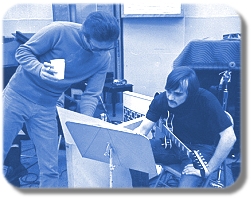 |
Capitol
Records session with David Axelrod and a
young Pedro while recording
Song Of Innocence 1968 |
enough to clear my doubts, but the encouragement
that he gave me has kept me going all these years.
The Lou Rawls dates, other odds and ends I did
for him
were among the most treasured memories of
my musical career. The top level musicians that
I played with in those days gave me experience
I'll never forget, I'll always owe a lot to David
Axelrod.
Nadie me ha dado mis capacidades musicales mas
apoyo y confianza como hacia Dave Axelrod in los
60. Cuando èl producia a Hardwater en Capitol,
fui un joven hippie quien pensaba que puedo tocar
bien en el nivel local, pero tuve poca confianzia
que puedo igualar a Eric Clapton and los grandes
guitaristas del tiempo. El me contracò
para tocar los solos en "Song of Innocence"
con mi idolo, Howard Roberts tocando el accompaniemento.
Eso en si fue bastante para borrar mis dudas,
pero el animo que me daba me ha inspirado todos
estos años. Las fechas con Lou Rawls, los
otros various grabaciones son de las memorias
mas preciosas de mi carrera musical. Los musicos
de lo mas alto nivel con quienes he tocado en
aquellos dias me dieron las experiencias que nunca
voy a olvidar, siempre deberé mucho a David
Axelrod.
__________________
Top
of Page

Earl Palmer
EarlPalmerMemorial.com
Earl
Palmer on Wikipedia
 My relationship with Earl Palmer went way past
the great musical memories I have from playing
with the master, he was a friend. My relationship with Earl Palmer went way past
the great musical memories I have from playing
with the master, he was a friend.
His 2 sons Earl jr., Donald and I got an apartment
in the Wilshire district with another buddy, Bat.
One night Earl came to take us all to the annual
football game between Alcorn State and Grambling.
Earl apologized profoundly because he forgot to
get a ticket for me, no big deal, I got drunk
instead. The next thing I know Earl and the boys
are frantically trying to wake me up and the apartment
was full of dense smoke. I had left a cigarette
burning in an ashtray on the sofa . The sofa was
about to erupt in flames, if they wouldn’t
have come when they did, I don’t know if
I would be here to tell the story. I saw Earl
at a session en Dimension recorders a few months
later. “Pete, you cost me a lot of money”,
he said, but he was LAUGHING about it. I begged
him to tell me what this episode cost so I could
pay him back but he would hear none of it. “Aw
man, don’t worry about it, s’ nothin”.
That’s the kind of guy he was.
One afternoon I was walking past the coffee
shop at 3000 Sunset and I heard a rap at the window,
it was Earl motioning me to come in and join him
and his friend for coffee. I sat down, and the
friend was none other than the legendary bassist
Ray Brown, I was floored. We chatted for about
an hour and a half about everything from Richard
Nixon, to the Dodgers, to Howard Robert’s
influence on young guitar players. I would be
happy to have shook Ray’s hand, but to HANG
with him was heaven.
The last time I saw Earl was at one of the
Tuesday nights at Chadney's. I didn’t know
it was a jam and Earl was bummed I didn’t
bring my axe. We did a lot of catching up and
told me that he was writing a book, and the sofa
incident was to be included and to come back and
see him before I moved to Mexico. I left the next
week and just couldn’t make it to see him
again so I wrote a letter and left it with a friend
to deliver. Unfortunately , signals got crossed
and it was never delivered, next thing I know,
10 years later he was gone.
I teach a history class on the beginnings
of rock, 50’s & 60’S. One thing
I overlooked, that Carol Kaye pointed out in an
interview, is the influence of the studio musicians
of the time. Earl. Don Randi, HowardRoberts, Carol,
Tommy Tedesco etc. were all jazzers, making their
living in the studios. The charts were never that
specific, just chords and punches etc, and the
musicians improvised and created their parts.
These grooves became the basis for tons of tunes
written afterwards and are STILL being used. The
patterns for “Be My Baby” by the Ronettes
for example, was used for “Don’t Worry
Baby” by the Beach Boys, later for “Mr.
Tambourine Man” by the Byrds and on and on.
Earl’s grooves were the backbone for tons
of these kinds of tunes. “The best damned
session drummer of all time” said Carol ,
which is a lot considering the company of the
time, Hal Blaine, Bernard Purdie. Jim Gordon etc.
But I don’t see how one could disagree.
I think a lot about Earl still, he is in
my daily prayers, and I thank God, AND Dave Axelrod
for giving me the opportunity to know this grand
gentleman.
Mi relación con Earl Palmer sobresalio,
por mucho, las memorias musicales marivillosas
que tengo por tocar con este gran maestro, fue
compañero.
Sus 2 hijos, Earl hijo y Donald y yo, con
otro cuate, Bat, tuvimos un departamento en el
distrito Wilshire en LA. Una noche Earl vino para
traernos al juego de fútbol Americano con
Alcorn State y Grambling. Earl, profundamente
ofreció desculpas porque se olvidó
a conseguir un boleto para me, no gran cosa, me
emborraché entonces. La próxima
cosa que sabia, Earl y los chavos están
frenéticamente tratando a despertarme y
el departamento se llenaba con humo bien denso.
Yo había dejado un cigaro prendido en el
cenicero en la sofá. La sofa iba a eruptar
en llamas, si no hubiesen llegado cuando hicieron,
no sé si estaría aquí en
hoy dia para contar la cuenta. Meses luego vi
a Earl en un sesión en Dimension recorders.
“Pete, me costaste mucho dinero”, dijo,
pero ESTABA RIENDO de esto. Le rogaba a decirme
cuando le costó mi tontería que
le puedo pagar, pero el no escucharía nada
de eso. “Mano, no pienses 2 veces en esto,
es nada”. Esto fue la clase de hombre que
fue.
Una tarde I estoy caminando por la restuarant
en 3000 Sunset y escucho alquien tocando la ventana,
fue Earl invitándome a unirme con él
y su cuate para un cafecito. Me senté y
su cuate fue el bajista legendario, Ray Brown,
Sali assombrado. Charlabamos una hora y media
sobre todo de Richard Nixon, Los Dodgers, y la
influencia de HowardRoberts en los jóvenes
guitarristas. Yo hubiese sido contento de estrechar
manos con él, pero CONVIVIR con él
fue padrísimo.
La ultima vez que vi a Earl fue en una de
las noches de martes en Chadneys. No sabia que
fue un jam y Earl salió desanimado que
no trajé mi guitarra. Charlamos mucho,
y me informó que esta escribiendo un libro
y la incidente de la sofa seria incluido, y que
yo regrese a verlo antes que cambio a Mexico.
Deje la próxima semana y no pudo regresar
por verlo, pero le escribí una carta y
lo dejé con un amigo por entregar. Desafortunademente,
por una razón u otra, el sobre nunca fue
entregado, la próxima cosa que sabia, 10
años después, Earl ha ido.
Enseño una clase de la historia de
los principios de rock, los 50 y 60. Una cosa
que no me dio cuenta, que mencionó Carol
Kaye en un entrevista, es la influencia de los
músicos del estudio de esta época.
Earl, Don Randi, Howard Roberts, Carol, Tommy
Tedesco etc., eran jazzistas, ganando la vida
por tocar en los estudios. Las cifradas nunca
eran tan especificas, solo cambios de acordes
y obligatorios etc., y los músicos improvisaron
y crearon sus propios partes. Estes grooves salieron
como el basis por toneladas de rolas después
y están usados TODAVIA. Los patrones de
“Be My Baby” por Las Ronettes por ejemplo,
fueron usados por Dont Worry Baby” de Los
Beach Boys, y luego por “Mr.Tambourine Man”
de Los Byrds y continua y continua. Los ideas
de Earl eran la espina de muchos be estas rolas.“El
mejor maldito baterista de los estudios de todos
los tiempos” dijo Carol. Considerando la
compañía de la época, Hal
Blaine, Bernard Purdie, Jim Gordon etc., esto
dice mucho. Pero, no veo como uno puede dar argumento.
Todavia pienso mucho en Earl, todos los días
en mis oraciones, y doy gracias a Dios, Y Dave
Axelrod por darme la oportunidad de concocer este
gran cabellero.
Top
of Page
|
Howard
Roberts (1929-1992)
Musicians
Institute (formerly known as the Guitar
Institute) co-founder and inspiration Howard
Roberts poses with his new Gibson Howard
Roberts model guitar (c.1980). Throughout
the 1950s, '60s and '70s, HR was one of
the busiest guitarists in Los Angeles, appearing
on hundreds of album, movie and TV dates,
and his own LPs established him as one of
the premier jazz guitar stylists of his
generation. He applied a lifelong passion
for learning theory to writing books and
columns as well as conducting legendary
seminars. His efforts raised the standards
for guitar education and culminated in the
establishment of GIT, the world's first
full-time contemporary guitar program.

When I started playing
guitar, I heard "HR Is a Dirty Guitar
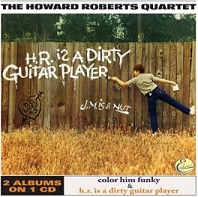 |
| RE-Released
on CD - Color Him Funky & H.R. Is A
Dirty Guitar Player. Music history
was made in February 1963 at Capitol
Records' Studio A in Hollywood. That's
when Howard Roberts began recording
a series of albums that would set the
standard for compelling guitar-oriented
arrangements. |
Player". I was floored,
I bought it and learned everything I could
from it. Later in the 60's, Dave Axelrod
hired me to play to play along side of HR
in " Song of Innocence", the 1st
of several sessions I did with Howard. In
1980 I went to GIT, studied a year and became
a teacher there. Howard has been with me
almost my whole career. I owe him a lot
as a mentor, musician and friend.
Cuando empecé con la guitarra, escuché
a "Howard Roberts is a Dirty Guitar
Player" y me asombró, lo compré
y aprendí todo que pueda. Luego en
los 60, Dave Axelrod me contrató
por tocar con HR en "Song of Innocence",
el primer de algunas sessiones de grabaaciones
que hice con Howard. En 1980, me fui a GIT,
estudiaba un año y sali como maesto
alla. Howard ha estado conmigo casi todo
mi carrera. Le debo mucho como mentor, musico,
y amigo.
Top
of Page 
Carol
Kaye
AllAboutJazz-
Carol
Kaye -
She is a First Call L.A. Studio Bassist |
Karol
Kaye Website
 I
had learned very early in my career to
never underestimate the abilities of a
woman playing music, but nothing prepared
me for Carol Kaye. Axelrod and Earl Palmer
had told me that the lady was incredible
and I had no reason to doubt them. But
I wasn't prepared to sit next to Carol
in the studio. When she entered the studio,
I immediately thought of my kindergarten
teacher, Mrs. Stone. When Don Radii gave
the 1st countdown, I immediately lost
my place in the chart, I couldn't believe
what I was hearing. It wasn't that I couldn't
believe that a woman was playing like
that, it was because I couldn't believe
the bass could be played like that. Right
off the bat, her and Earl Palmer connected
and started ping-ponging the groove every
which way, all I could do was listen in
amazement. Luckily I could compose myself
for the 2nd take and everything came out
ok. I
had learned very early in my career to
never underestimate the abilities of a
woman playing music, but nothing prepared
me for Carol Kaye. Axelrod and Earl Palmer
had told me that the lady was incredible
and I had no reason to doubt them. But
I wasn't prepared to sit next to Carol
in the studio. When she entered the studio,
I immediately thought of my kindergarten
teacher, Mrs. Stone. When Don Radii gave
the 1st countdown, I immediately lost
my place in the chart, I couldn't believe
what I was hearing. It wasn't that I couldn't
believe that a woman was playing like
that, it was because I couldn't believe
the bass could be played like that. Right
off the bat, her and Earl Palmer connected
and started ping-ponging the groove every
which way, all I could do was listen in
amazement. Luckily I could compose myself
for the 2nd take and everything came out
ok.
At first, I was a little upset with some
of the sexist comments that the musicians
would throw at her, but she was used to
it, she was just one of the boys and laughed,
just Hollywood studio humor. They all
respected her a lot.
I think the next time I played with her
was the "Release of an Oath"
sessions for the Electric Prunes at the
Sound Factory. We arrived at the same
time and she wasn't feeling well so I
carried her instruments in for her. "You
may be the boogienest bass player in the
world, but you are still a lady",
I told her, and she was very charmed and
appreciative, she was used to the comments
of the other musicians.
I believe that was the last session I
did with her but I would see her from
time to time and we had great little chats.
The last time I saw her was early in the
80's when I was at MI. She came to do
a seminar so I approached her when she
was tuning up. I was flattered that she
remembered me so well.
I have never hesitated to use women in
my bands thorough the years, if the best
man available is a mamacita, then she
would get my 1st call without any hesitation,
and this has given me a lot of wonderful
musical memories, and it all started with
the best, Carol Kaye.
He aprendido muy temprano en mi carrera
que nunca subestimaré las capacidades
de una mujer que toca la musica, pero
nada me preparó por Carol Kaye.
Axelrod y Earl Palmer me habian dicho
que fue increible y tuve no razón
ninguna para dudarles. Pero, no estuve
preparado para sentarme junto a Carol
en el estudio. Cuando ella entró
el estudio, imediatemente pensé
en mi maestra del kinder, Sra. Stone.
Cuando Don Randi contó la velocidad
de la primera rola, me perdí, al
instante, mi lugar en la cifrada, no creia
lo que escuchaba. No es como si fuera
que no creia que una mujer esta tocando
asi, fue porque no creia que el bajo puede
ser tocado en esta manera. Del principio,
ella y Earl Palmer se conectaron y jugaba
con el ritmo en cualquiera manera posible,
y todo que pude hacer fue a escuchar asombrado.
De suerte, pude componerme por el segundo
tomo y todo salió bien.
Al principio, me descompuse algunas de
los comentarios sexistos de los otros
musicos, pero ella fue acostumbrada, fue
uno de los chavos y reia, fue el humor
de los estudios de Hollywood. Los musicos
tuvieron mucho de respeto para ella.
Pienso que la proxima vez que toqué
con ella fue los sessiones de "Release
of an Oath" de Los Electric Prunes
en el Sound Factory. Nos llegamos al mismo
tiempo y ella no se sentia muy bien, entonces
llevé sus instrumentos al estudio
para ella. "Puedes ser el bajista
mas padre en el mundo, pero todavia eres
una dama". le dije, y ella salio
muy encantada y agredecida, ella se acostombraba
a los comentarios de los otros musicos.
Creo que esto fue la ultima session que
hice con ella, pero la veia de vez en
cuando y teniamos buenas charlitas.
La ultima vez que la vi fue temprano en
los 80 cuando estuve en MI. Habia venido
por dar un seminario entonces me acercé
a ella cuando afinaba. Me agredeció
que ella se recordó bien de mi
tanto.
Nunca he hestitado de usar las mujeres
en mis grupos atraves los años,
si el mejor hombre disponible es mujer,
ella rebibirá mi primera llamada
sin hesitar, y esto me ha dado muchas
memorias musicales marivillosas, y todo
empezó con la mejor, Carol Kaye.
|
Top
of Page

Steve Trovato
SteveTrovato.com
 Steve Trovato should have his picture
on the cover of Guitar Player magazine.........every
month! The cat is absolutely amazing. Steve Trovato should have his picture
on the cover of Guitar Player magazine.........every
month! The cat is absolutely amazing.
Steve and I became friends in 1980 when
we were students at GIT. Ever since then,
we've learned a lot from each other. One
day he heard me playing my steel guitar
bends in the halls and he was amazed, "I've
never heard the guitar played like that
before," he said. I showed him the
8 or 9 licks that I knew and the boy took
them and created a whole new way of playing
country music. I still only play the 8 or
9 licks, but he'll stun you with what he
did with them. We jammed and hung out all
that year, and after graduation he joined
me in Pedro and the Chinamen. A ton of musicians
have played with me in that group, but nobody
more than Steve. We had that group for ten
years, mostly playing in Venice
Beach, California.
Steve was always good as a student, but
when we got out, he just exploded. We'd
be playing and he'd take a solo and my jaw
would drop. "What has this boy been
taking, and where can I get some"?
Every gig he was twice as good as the last
one. I almost became scared to be on the
same stage. But the truth is that he made
me better. I had to give everything or he'd
make me look bad. So I practiced more and
more and got better because of Steve.
His chops are absolutely incredible, so
percusive and in such perfect time.
As the eighties went on, Steve developed
more interest in blues. He learned alot
about this music from me, but as always,
he superceeded in this idiom. Although he
can play Steve Vai fast, he now plays blues
with frasing as sweet as the water in a
Colorado mountain stream.
He put in some good words for me at MI and
helped me gain a teaching position there.
He was also responsible for putting me on
the MI Blues play along project. But more
than anything, I owe him a lot for inspiring
me and making me a better player.
I've always felt that Steve didn't get the
recognition that he deserves on a global
level. Hes not really what you would call
unknown, but the world should be cognitive
of his amazing talents.
Steve Trovato debe ser en la portada de
la revista Guitar Player......... todos
los meses. El tipo es absolutemente asombroso.
Steve y yo salimos amigos en 1980 cuando
eramos alumnos en GIT. Desde hace entonces,
hemos aprendidos mucho uno a otro.
Un dia, él me ecuchó tocando
mis bends de steel guitar en los pasillos
de la escuela y él salio asombrado.
"Nunca escuché la guitarra tocado
en esta manera" me dijo. Le enseñé
mis 8 o 9 frases que sabia y el chavo las
llevó and creaó una manera
completemente nueva de tocar la musica country.
Todavia toco los mismos 8 o 9 frases pero
él te meta en schock con lo que hizo
con ellas. Nos jamiamos y colgemos todo
este año, y depspues de graduar,
él me unió en Pedro and the
Chinamen. Un montón de musicos tocaron
conmigo en este grupo, pero nadie mas que
Steve. Tuvimos ese grupo por 10 años,
mas veces tocando en Venice Beach, Ca.
Steve are muy bueno como alumno, pero cuando
graduamos, él se explotó.
Estabamos tocando, y cuando tocó
un solo, sali assombrado. Digo, "Que
esta tomando este chavo, y donde puedo consiguir
algo"? Cada tocada, él tocó
doble de lo que hizo antes. Casi temia subir
el mismo escenario con él. Pero la
verdad es que me hice mejor. Tuve que darlo
todo o me haria parecer mal. Yo practicaba
mas y mas y me mejoré por tocar con
él.
Sus habilidades son absolutemente increible.
Tan percusivo y en ritmo perfecto.
Atraves los 80, Steve desarolló mucho
enteres en el blues. El aprendió
mucho de esta musica de mi, pero de siempre,
el sobresalió en este idioma. Puede
tocar rapido a la Steve Vai, pero ya toca
el blues con fraseo dulce como el aqua de
un arroyo de Colorado.
El me recomendió y me ayudó
en conseguir un puesto de maestro en MI.
Tambien fue responsable por metirme en el
projecto de MI Play Along. Pero mas que
nunca, le debo mucho por inspirarme y hacerme
un mejor guitarrista.
Yo siempre he pensado que Steve nunca recibió
el reconiciemento que merece en un livel
global. No es exactamente desconocido, pero
el mundo debe ser cognitivo de sus grandes
talentos.
|
Top
of Page
 -NEWS Dec. 2011 -NEWS Dec. 2011
Posted by Michalis Limnios BLUES @ GREECE on December 31, 2011
Article from Greece, content largely shared from MrPedro.com

|
_________________________________
Top
of Page
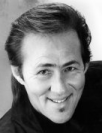 John
Herron John
Herron
 I had found my musical
identity with the progressive avant guarde group
“The Spinning Wheel” but when the group
broke up, I knew it was time that I had to grow.
I needed to be in a band where I was the weakest
member. I had found my musical
identity with the progressive avant guarde group
“The Spinning Wheel” but when the group
broke up, I knew it was time that I had to grow.
I needed to be in a band where I was the weakest
member.
I was playing with
one of the various mutations of “The Moonrakers”
when we started a tour of the southwest US in
Colorado Springs by playing on a show with the
“Young Rascals”, a popular group at
the time. A band called the GNP opened the show.
They were a little outdated, matching uniforms
and doing steps but they were James Brown tight,
and they had a Hammond organ player that was incredible,
and he was on fire that night. I had adored Jimmy
Smith and studied the playing of Kenny Burrell
and had always dreamed of playing with someone
with that concept.
When we got back from
the tour, I had gotten a call from the GNP inviting
me to join the band and play a club date in Honolulu
for 3 months. It was 7 nites a week, from 7:30
to 3:30, a lot of playing. After thinking about
it awhile, I accepted. Id never played with a
band that was that well arranged and disciplined.
So many hours a night would give me the experience
that I needed, but most of all I was knocked out
by the chance of playing in a band with a Hammond.
The organist, John
Herron and I flew to Honolulu together and hit
it off real well. We liked the same music, same
artists, same career objectives and we both wanted
to do original music. The year was 1967, “the
summer of love”.
I got everything I
needed from playing that gig, I had improved immensely,
but most of all I had found a musical soulmate
in John. When the gig ended, I joined
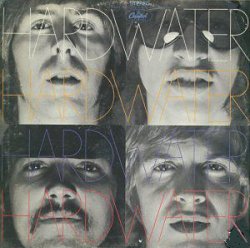 |
Hardwater
- Capitol Records |
|
Hardwater- CD
ReReleased 2011 in England |
the Astronauts. I loved
the group in their surf days, but now they were
just playing gigs. The reason I joined is that
they were going to LA, change the name to Hardwater and record
for Capitol Records. Musically the group was pretty
unexciting after playing with the Spinning Wheel
and GNP, but I looked at it as a stepping stone
to get involved with the recording industry. I
always knew that John and I would play together
again.
Our manager was also
the manager of the Stevie Winwood, 10 Years After,
and the Electric Prunes a musically terrible group
that had a couple of hits, but were all basket
cases. The manager asked
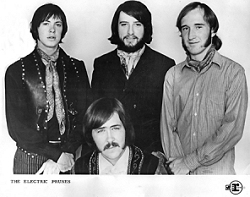 |
John
Herron front center |
us if we knew a group
that could replace them, continuing with name.
John had a group with Richard Whetstone called
"Climax” and
they became the Prunes. They recorded an two albums
for Warners-Reprise and Richard did the superb
vocals for Dave Axelrod’s “Release of
an Oath”. Meanwhile, the Astronauts, which
had become “Hardwater” had recorded
an album that went nowhere but I had become tight
with Dave Axelrod. I decided that Id gotten all
I could from that situation and quit. Meanwhile,
Axelrod wanted to continue with me and offered
me a contract with Capitol Records and asked me
to put a group together. John was disillusioned
with being a Prune so he joined me with Rob McLerran
who had been the bassist with The Spinning Wheel
and Hardwater, and Earl Palmer’s son Donald
on drums. 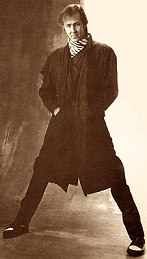
John had met Juddy Phillips,
Sam’s nephew and wanted to start a production
company. The idea was to be Stax west. He wanted
the band to be the house band and persuaded me
to leave Axelrod which was probably the worst
career move Ive ever made. Dave wanted to go all
out with my album but I loved working with John
so much that I told Dave I was leaving, he never
forgave me for that.
|
_________________________________
We did a lot of projects.
We placed a group from Interlochen Arts Academy
led by Chris Brubeck, Daves 2nd son, did a soundtrack
for an unsuccessful movie called “Last of
the American Hoboes”, a soul singer named
Al Johnson, recorded some demos with Dr. John,
(then known as the Night Tripper), and we had
our own project called “Demon Rum”.
I learned lot about the music business from our
inexperience. Joe Sutton, who was Neil Diamonds’s
mgr. made us believe that we were going to get
$100,000 from A&M records. We were so young
and stupid that we fell for it. We had received
an offer of $11,000 from Mercury, and a separate
offer from A&M for $10,000 which we rejected.
We ended up with nothing and the whole project
fell apart.
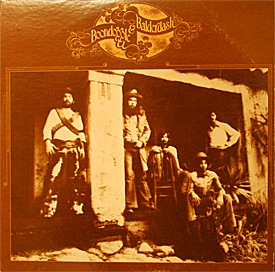 John
had started writing tunes at that time, all instrumentals
but had teamed with Rob who was a fine lyricist.
They later formed a group that recorded an album
for Uni Records called Boondoggle and Balderdash and John was growing
as a writer. But this was the time that John and
I started drifting apart musically and as friends.
He asked me to play with the band, but under the John
had started writing tunes at that time, all instrumentals
but had teamed with Rob who was a fine lyricist.
They later formed a group that recorded an album
for Uni Records called Boondoggle and Balderdash and John was growing
as a writer. But this was the time that John and
I started drifting apart musically and as friends.
He asked me to play with the band, but under the
|
Boondoggle
& Balderdash
John Herron & Rob McLerran |
condition that all my solos
were to sound like Don Preston from Leon Russell’s
band. Ive played with Don and he is a fine guitarist,
but he was Don and I wasn’t, so I declined.
I ended up playing a couple of solos on the album
anyway. After that project died, John realized that
he had to work alone and not depend on anyone else
and dedicated his talents to develop his songwriting.
John and I had been
the best of buddies all these years, but the musical
directions were starting to get very opposite.
We never were together again in any serious musical
projects.
I had moved back to
Colorado and returned in 1980. I stayed with John
until I found my own place and we hung out a lot,
went to 30 Dodger games that summer. But John
was a changed man. He was very critical of my
musical ambitions. “Where do you think THAT
will get you” he would say anytime I mentioned
playing jazz. I just about couldn’t talk
with him about music anymore without this kind
of pummeling. And he was obsessed with “making
it.”
After I had graduated
from GIT, I started playing jazz and country and
the Sunset Saloon in Venice Beach. One Friday 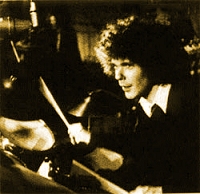 afternoon
I walked into the club and they asked me to throw
a band together for that night. I called Keith
Moret, an Afro-Cajun bassist with a tremendous
voice and called John who said he would dig up
a drummer. He showed up with Jim Gordon.
No rehearsal but we played like wildfire. It was
one of the most unforgettable nights of my career.
The audience was going absolutely nuts with every
tune and we were stoked. We played for 3 hours
before it dawned on us to take a break. Although
John and I were going opposite ways, the magic
on stage was stronger than ever. This was the
1st version of Pedro and the Chinamen. afternoon
I walked into the club and they asked me to throw
a band together for that night. I called Keith
Moret, an Afro-Cajun bassist with a tremendous
voice and called John who said he would dig up
a drummer. He showed up with Jim Gordon.
No rehearsal but we played like wildfire. It was
one of the most unforgettable nights of my career.
The audience was going absolutely nuts with every
tune and we were stoked. We played for 3 hours
before it dawned on us to take a break. Although
John and I were going opposite ways, the magic
on stage was stronger than ever. This was the
1st version of Pedro and the Chinamen.
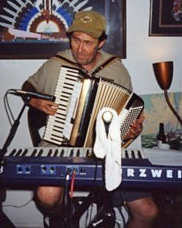 We
played together quite a bit during that decade
but John had become too involved with his songwriting
career and didn’t want to do the clubs much
anymore. Playing together was a musical orgasmic
expierence, but we both got involved with other
things, John had found other guitarists that he
used for his studio projects and the next thing
I knew we had just stopped seeing each other.
I don’t think we talked once in the 90’s. We
played together quite a bit during that decade
but John had become too involved with his songwriting
career and didn’t want to do the clubs much
anymore. Playing together was a musical orgasmic
expierence, but we both got involved with other
things, John had found other guitarists that he
used for his studio projects and the next thing
I knew we had just stopped seeing each other.
I don’t think we talked once in the 90’s.
I had moved to Mexico
and one night I had got a call from Rob McLerran
who told me of John’s accident and that he
was in a coma and not given any chance to survive.
He gave it a good fight, just like always but
the injuries were too grave. A few months later,
my friend Greg Kacheoff called me and informed
me that we had lost John.
I felt so bad that I
couldn’t do anything to help, that I would
never play music with him again...I would never
see him again.
Years later the sadness
has diminished but not the frustration about the
way our friendship ended. But he was a prince.
Once in a lifetime person who I had the priviledge
of knowing, playing with, and loved as a friend.
Top
of Page
_________________________________ |